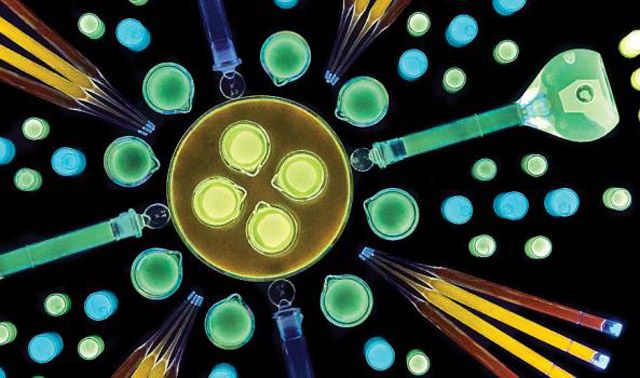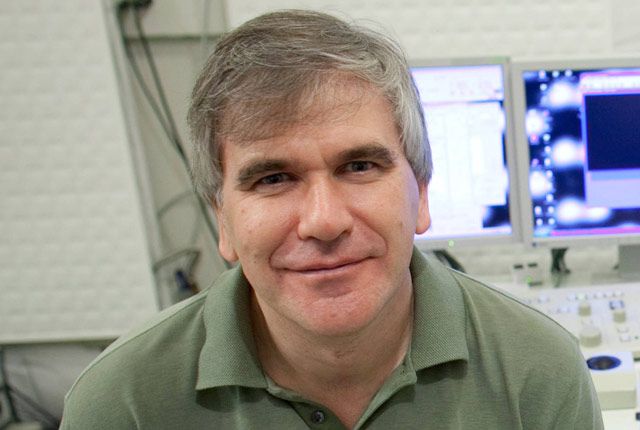Quantum dots (QDs) are semiconducting nanocrystals prized for their optical and electronic properties. The brilliant, pure colors produced by QDs when stimulated with ultraviolet light are ideal for use in flat screen displays, medical imaging devices, solar panels and LEDs. Yet the difficulty and expense associated with current manufacturing methods -- often requiring heat, high pressure and toxic solvents -- has stood in the way of mass production and widespread use of these wonder particles.
But now, three Lehigh University engineers have successfully demonstrated the first precisely controlled, biological way to manufacture quantum dots using a single-enzyme, paving the way for a significantly quicker, cheaper and greener production methods.
"The biological approach reduces production time and resources while easing environmental impact," says Bryan Berger, Class of 1961 Associate Professors of chemical and biomolecular engineering.
Conventional QD manufacturing costs can total $1,000 to $10,000 per gram. The new Lehigh technique is expected to slash the price by at least a factor of 10.
Berger happened across this idea while on a completely different mission, studying the ability of a nasty hospital-borne bacterium – a so-called superbug -- to thrive on metal. The microbe, Stenotrophomonas maltophilia, or steno for short, appeared to be absorbing tiny electrical charges from the metal surfaces and creating QDs.
Berger joined forces with Steven McIntosh, another Class of 1961 Associate Professors of chemical and biomolecular engineering, and Chris Kiely, Harold B. Chambers Senior Professor, materials science and engineering, to make sense of the processes involved. Soon, the team – which eventually grew to include graduate students Chris Curran, Li Lu, Leah Spangler, Zhou Yang and undergraduate Robert Dunleavy ’16 -- was focused on re-engineering the bacteria into miniature QD factories.
Last year, the researchers discovered that a single enzyme produced by the bacteria was responsible for selectively producing cadmium sulphide QDs, and their breakthrough was featured on the cover of Green Chemistry.
"We’d evolved the enzyme beyond what nature intended," says McIntosh. “It has been engineered to form and control QD crystal structure and size. This allows for uniform manufacturing of QDs that emit any particular color -- the very characteristic that makes this material attractive for many applications.”
The prospects for widespread adoption of a system with a highly-contagious and deadly ‘superbug’ at its core seemed slim at best, so the team searched for – and found -- a more suitable biofactory environment. Earlier this year in the Proceedings of the National Academy of Sciences (PNAS), they demonstrated that the required enzyme can be synthesized from easily-engineered – and less problematic -- bacteria such as E. coli.
Lehigh's renowned Electron Microscopy and Nanofabrication Facility allowed for detailed structural analysis of individual nanoparticles, composed of tens to hundreds of atoms. The instrument scanned an ultra-fine electron beam across a field of QDs. The atoms scattered the electrons in the beam, producing a kind of shadow image on a fluorescent screen. A digital camera recorded the highly magnified atomic resolution image of the nanocrystal for analysis.
"Even with this new microscope,” says Kiely,” we're pushing the limits of what can be done.”
Current commercial QD development takes many hours, and requires additional processing and purifying steps. Biosynthesis, on the other hand, takes minutes to a few hours to create a full range of quantum dot sizes in a continuous, environmentally-friendly process under ambient conditions – with no post-processing steps needed.
The team is poised to scale-up its laboratory success into a manufacturing enterprise. Their goal is to help develop a plethora of QD applications such as greener manufacturing for a diverse set of products and industry sectors, power generation, water purification and even recycling.
Story by Lori Friedman




